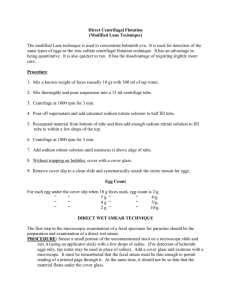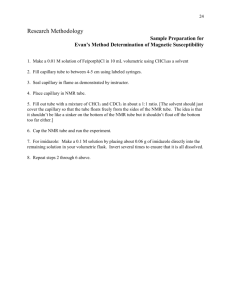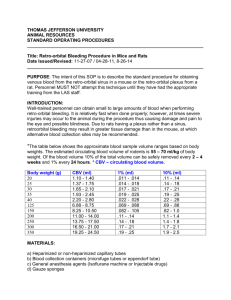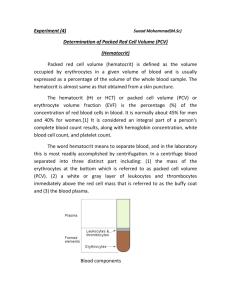Blood labs
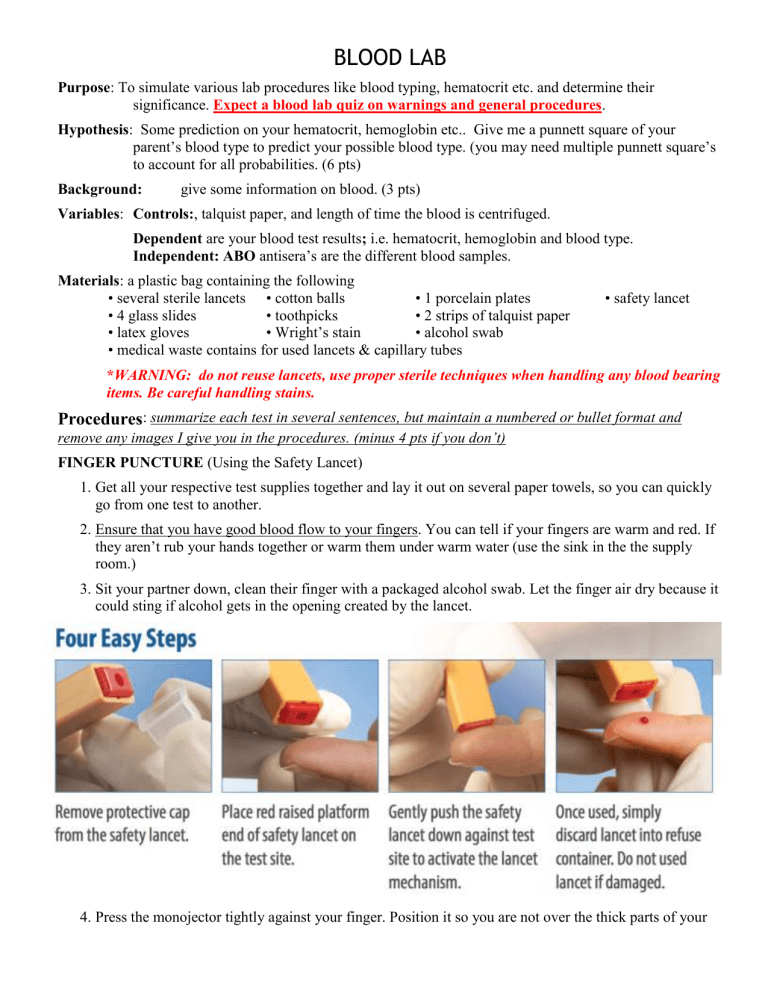
BLOOD LAB
Purpose : To simulate various lab procedures like blood typing, hematocrit etc. and determine their significance. Expect a blood lab quiz on warnings and general procedures .
Hypothesis : Some prediction on your hematocrit, hemoglobin etc.. Give me a punnett square of your parent’s blood type to predict your possible blood type. (you may need multiple punnett square’s to account for all probabilities. (6 pts)
Background: give some information on blood. (3 pts)
Variables : Controls: , talquist paper, and length of time the blood is centrifuged.
Dependent are your blood test results ; i.e. hematocrit, hemoglobin and blood type.
Independent: ABO antisera’s are the different blood samples.
Materials : a plastic bag containing the following
• several sterile lancets • cotton balls
• 4 glass slides • toothpicks
• 1 porcelain plates
• 2 strips of talquist paper
• latex gloves • Wright’s stain • alcohol swab
• medical waste contains for used lancets & capillary tubes
• safety lancet
* WARNING: do not reuse lancets, use proper sterile techniques when handling any blood bearing items. Be careful handling stains.
Procedures
: summarize each test in several sentences, but maintain a numbered or bullet format and remove any images I give you in the procedures. (minus 4 pts if you don’t)
FINGER PUNCTURE (Using the Safety Lancet)
1.
Get all your respective test supplies together and lay it out on several paper towels, so you can quickly go from one test to another.
2.
Ensure that you have good blood flow to your fingers. You can tell if your fingers are warm and red. If they aren’t rub your hands together or warm them under warm water (use the sink in the the supply room.)
3.
Sit your partner down, clean their finger with a packaged alcohol swab. Let the finger air dry because it could sting if alcohol gets in the opening created by the lancet.
4.
Press the monojector tightly against your finger. Position it so you are not over the thick parts of your
finger tips (this varies from person to person.) Sometimes it works better to squeeze blood into your finger tip so it is purple (dark red) in color and position monojector closer to the tip of the finger.
*** You must hold your finger still while you perform this step.
5.
Conduct your tests. Repeat the puncture if you run out of blood to complete all the tests.
AFTER YOUR TESTS:
1.
Wearing your latex gloves, clean all your equipment off with alcohol and be sure to throw anything sharp with blood on it (the safety lancet and hematocrit tubes) in the BIOHAZARD waste container.
2.
The slide that you used to smear your blood droplet should be put in the beaker filled with alcohol to serilize it.
3.
Switch roles with your partners.
HEMATOCRIT TEST
1.
Your partner must be wearing latex gloves for all these procedures. Your partner will have a heparinized capillary tube ready. These tubes are very fragile so handle carefully.
2.
There are two ends to this capillary tube, one end has a red line about ½” from the end, while the other doesn’t have any lines. Press the red-lined end of the heparinized capillary tube into the blood. Angle it downward so gravitational and capillarity forces will suck blood into the tube until it is filled to 2/3 to
¾ full. Be sure to continuously roll the tube in your finger as the blood fills the tube.
3.
There are several plastic containers with small holes in it and yellow wax below the holes. Before you start filling the capillary tube be sure that you’ve found a hole with wax below it. To prevent the blood from leaking back out of the tube you must press the bloody end of the tube into the sealing wax.
4.
Clean and dry the outside of the tube and take it to your teacher to spin in the centrifuge.
5.
Give the tube to your teacher. REMIND YOUR TEACHER to place the protective cover on the top of the hematocrit tray before spinning.
6.
Counter balance the centrifuge by placing one tube opposite another on the centrifuge’s tray. The tube will be placed into the centrifuge and spun for 3 minutes. ** Remember your tube’s position number in the centrifuge .
7.
After the centrifuge has stopped, read the tube by following steps 8-10.
8.
The capillary tube will have the red blood cells packed down at one end and clear plasma on top. You can slide the capillary tubes towards center or the edge of the tray. Slide the tube so the red line at the bottom of the packed red blood cells (use the magnifying glass) with the "0" line on the calibrated plate.
9.
The tray is two parts the top portion with lines and numbers and the metal bottom portion. Reaching under the top plate, hold it steady while rotating the top tray so the top of the clear plasma is lined up with the 100% line on the calibrated top plate. USE THE
MAGNIFYING GLASS TO MAKE SURE THAT THE
BOTTOM OF THE PLASMA MENISCUS IS ON THE
100% LINE.
10.
Use the magnifyer to determine the hematocrit value. This is the point where the blood and plasma separated. See normal values in the notes.
BLOOD TYPING
1.
After filling a capillary tube squeeze out a drop into each of the three depressions of a porcelain blood typing dish.
2.
Place two or three drops of each antisera (A, B and rh or D) in a separate depression on a porcelain plate.
Don’t use too many drops because I only have 5 ml’s of each antisera.
3.
Using a separate tooth pick for each well, stir the antiseras and blood.
* MAKE SURE YOU THROW THE USED TOOTH PICKS INTO BIOHAZARD WASTE
CONTAINER.
4.
After ONE MINUTE tilt the porcelain dish back and forth, so you can tell if there are any blood clots.
***USE ALCOHOL TO CLEAN OFF THE CERAMIC PLATES.
5.
Use the accompanying blood type booklet or a textbook to determine your blood type based on it’s reaction to the antiseras.
PREPARATION OF A BLOOD SMEAR
1.
Prepare two, clean dry microscope slides.
2.
Label one slide (the one that will have the blood smear) with your initials.
3.
Place the other slide on a 45° angle on top of one end of the labeled slide and practice pushing the top slide all the way across the labeled slide.
4.
After practicing, now place a drop of blood on one end of the bottom (labeled) slide. Now slowly slide the top slide over until it makes contact with the drop of blood. Wait until the drop of blood has spread across the bottom edge of the top slide. Then, using the technique practiced in step 3, smear the blood across the slide.
** The smearing motion must be done quickly, leaving a thin smear.
5.
Let the blood "air dry", while cleaning-up the top slide (used to smear the blood drop) with alocohol (or alcohol swab) and returning it to the slide tray.
6.
Place the air dried slide into the Wright's Stain.
7.
After 3 MINUTES , remove slide and drop three drops of distilled water on the slide and let stand for an
ADDITIONAL 4 MINUTES.
** Don't wash off the stain after you remove it from the container.
8.
After the 4 minutes rinse off the stain with DISTILLED WATER.
9.
Let stand until dry.
10.
When examining slide, most of the cells will be Red Blood Cells. The White Blood Cells will appear bright bluish in appearance. The platelets will usually be in clumps and will also appear bluish in color.
Hint: use textbook to identify the different cells
DETERMINATION OF HEMOGLOBIN CONTENT
1.
Touch your fingertip to place a drop of blood on a piece of Talquist paper.
2.
When the blood is absorbed and loses its sheen, then quickly match the color with the chart provided in the Talquist paper holder.
3.
DON’T let the blood drop dry before comparing it to the hemoglobin scale because it will
affect your results.
Data Collection:
1.
Create a data table with hematocrit readings, blood type, and hemoglobin content for each lab partner. (4 pts)
2.
Draw and label (one for each lab partner) the overall blood smear slide. Be sure to include red blood cells, neutrophils, eosinophils, basophils, platelets and monocytes. You may have to look around at several spots on the slide to find them. Use your notes or the textbook as a reference. (5 pts ea.)
Data & Results:
1.
Why do the capillary tubes contain heparin? (1 pt)
2.
What does the hemoglobin content tell you as a testing procedure, i.e. explain the results on this test? (2 pts)
3.
What does a high hematocrit reading mean and give me some common causes for it? (2 pts)
4.
Explain how you would treat someone with a high hematocrit. (2 pts) give several treatments for high and low!
5.
What does a low hematocrit reading mean and give me several causes for it? (2 pts) give several reasons for high and low!
6.
Explain how you would treat someone with a low hematocrit. (2 pts) give several treatments for high and low!
7.
Explain how do antiseras work to determine what your blood type is? Hint: you may want to use terms like agglutinins and agglutinogens. (2 pts)
Conclusion :
Refer to you data results (DON’T say look at my data table) to address your hypotheses, in particular explain why your blood type is what it was. (8 pts)
Error analysis (i.e. how to improve the lab or procedural steps that will affect your results, so answers will not be accurate.)
Suggestions
